Genre: Action/RPG Developer: Climax Publisher: Sega Enterprises Players: 1 Released: 1993
Mention the game Landstalker to any veteran gamer and you’re bound to get one of two responses: a nostalgic sigh or a slew of profanity. You may even get a little of both. It is unique to the 16-bit era and when it leaves that much of an impression on its players, you know something was done right.
Back in 1993, not many console games used an isometric perspective. Of those that did, few were able to pull it off successfully ( The Immortal comes to mind), so it was understandable that many gamers were apprehensive about how well Sega’s new action/RPG would play. How would it control? What would the battles be like? How the heck do you make those jumps I saw in the pictures? Needless to say, Landstalker quieted most of its critics; most of them.
As Nigel the Wood Elf, you’re on a mission to find the legendary treasure of King Nole. Nole wasn’t exactly Mr. Popularity among his subjects, and made a hasty exit when his subjects stormed the castle. Neither he nor his treasure was ever heard from again, so it’s up to you to solve the mystery and heal the scars that still plague the land of Mercator, but mostly to find the treasure and retire wealthy!
That right there sets Nigel apart from all the other RPG heroes around. He’s not out to save the world, rescue the princess, squash a great evil, or prevent some demon’s return. He’s in it for the money, plain and simple. Greed is his primary motive and he’s not ashamed to admit it. If lands must be saved and evil conquered on the way, then so be it.
At the start of his journey he meets up with a fairy named Friday (that’s original) who agrees to take him to the treasure in exchange for his protection from other fortune hunters. Their relationship grows during the game and she becomes rather attached to Nigel. Friday, along with all the other characters in the game, is very well written and gives the game a certain personality that sets it apart story wise from typical RPGs of the era. This is good, as the game itself plays like a typical RPG. There are towns to visit, dungeons to clear, items to receive and use to advance the plot, etc. Nothing is really outstanding or revolutionary by today’s standards, but keeping in mind when it was released, I can’t really consider this a big flaw.
Nigel is no slouch when it comes to fighting. He packs a pretty mean sword that can be upgraded several times throughout the game. Fire, ice, and thunder are all available to him and are needed to pass certain areas. His armor and boots are also upgradeable. The game’s two button scheme makes fighting intuitive and easy, allowing you to successfully take on several enemies at once or beat feet should things get too hectic.
There are items galore to be had in Mercator, and none is more precious than life stock. Be it purchased from a local store or found on your journey, you will find yourself scouring every inch of the island to find them all. An herb called EkeEke replenishes your strength and will even revive you should you lose all your energy (courtesy of Friday). Rings improve your resistance to poison as well as increase your weapon recharge rate. You’ll need a full charge to take down powerful foes and to open new areas, so choosing the right ring can be vital.
In addition to his equipment, Nigel can use a myriad of statues, stones, and other goodies. From creating a raft to entering an exclusive club, each item has a specific purpose that makes them indispensable to advancing the plot. Some of them, however, are not explained in the item screen nor is their use divulged by the townspeople, so a bit or trial and error is required. I never found out what the heck the spell book is for, so if someone knows, share it with me!
Using Climax’s Diamond Dimension System (sounds cool, doesn’t it?), the game sports a look unique to the Genesis library. Sure, you can always tell a Climax game when you see one, but none of their other titles use this particular view. Everything is large and well detailed, with vibrant colors that squeezed the Genesis’ palette for all its worth. Some many say it’s a bit cutesy in appearance but that just adds to the charm, and charm is something that Landstalker has in spades.
Each screen is usually a single room, with the doors being a plank-like extension in the middle of one any of its four sides. All your basic RPG environmental mainstays are here: fire & ice levels, forests, spooky castles, caves, etc. All are quite appealing to the eye and Climax did a better job creating a believable world than say, Treasure’s Light Crusader . * Cue fanboy booing. .
The graphics come at a price though. Sometimes it’s hard to judge the distance between ledges and blocks and this can cause many gamers to ask for “serenity now” as they miss a key jump only to watch Nigel fall four levels to the entrance to the labyrinth. Those with little patience or ADD need not apply.
As if the twitchy jumps weren’t bad enough, the sheer size of some of the mazes and dungeons can pose a problem. It’s easy to get lost and wander in circles, and even easier to think you’re at the end, only to find yourself right back at square one. Luckily, there are save points to be found within each area, so your backtracking is cut down a bit.
One of the most important aspects of Landstalker is its soundtrack. I may tend to gush a bit when it comes to the music in Genesis games, but this is definitely a soundtrack worth having (it was released separately in Japan). There are numerous tunes (about fourteen) that are long and well-composed, all fitting the games different scenarios perfectly (I loved the Gumi chant!). Although many of the main themes are reused in different areas, they’re spread out enough as not to become too repetitive.
Menus and dialogue boxes sport the classic Climax “blub-blub” sound that Shining in the Darkness made famous. My only gripe is the über-annoying squawk that enemies make when you hit them. As most of them require multiple hits, the sound grates on you rather quickly.
Landstalker is truly one of the great action/RPGs out there. I don’t see the comparisons some people make to Zelda , as the only thing the two really share is the genre of which they are a part. Some common elements may be found in both but most games of this ilk use them as well. Climax’s title is original enough to stand on its own and is easily one of the best of its type. With a quest clocking in at about 30 hours, there’s plenty of gaming for those looking for a classic title for a rainy day.
While we’re on the subject of how good Landstalker is, where’s my sequel? I’ve been waiting for over a decade, Sega. I wasn’t fooled by Lady Stalker or Dark Savior and still have a bad taste in my mouth from Time Stalkers . I want a true sequel and I want it 2D, preferably on my GBA. Are you listening?
…and I’m still pissed about the box art.
In the end, anyone’s Genesis library would be better off with Landstalker in it. It’s becoming a bit hard to find complete but the effort is well worth the prize. The spotty jumps and huge dungeons may scare away some, but those willing to travel to Mercator will most definitely get their money’s worth.
SCORE: 9 out of 10

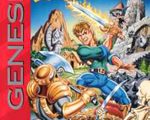
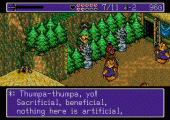
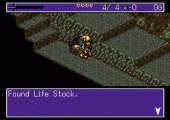
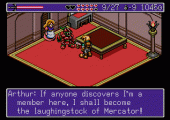
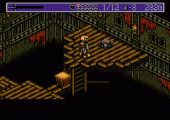
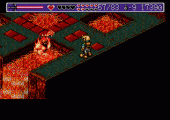
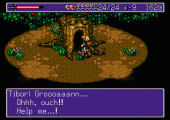
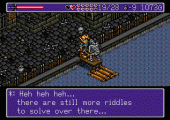
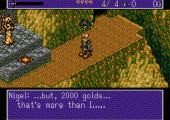
Great game. Took a chance on it when I saw on sale in a store way back in 93/94. Never looked back. Puzzles are tough but keep you coming back. The music is engaging and continues the fun feel of the graphics. The developers were well aware of the tricky sight lines created by the isometric perspective and take advantage of them when hiding items. It pays to explore!
Definitely a must play for any RPG & Genesis fan!!!